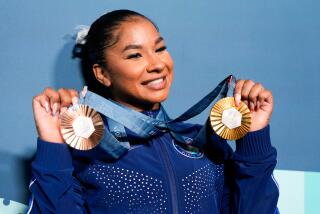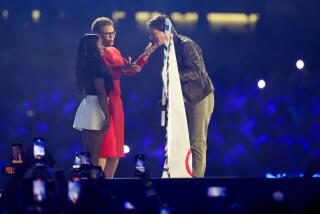The Best and the Biggest
You’ve probably never heard of Sirivanh Ketavong but no matter. Sirivanh is from Laos, and she’s a runner. Not just an around-the-block track star, but a world-class marathon runner. But being a runner from a poor country is much different than being a runner from a rich country, and when Sirivanh was training in Vientiane for the Sydney Olympics, she ran in the same pair of shoes she wore during the marathon in the Atlanta Olympic Games in 1996, and this, nearly four years later. When a U.S. aid worker stationed in Vientiane brought her a new pair, purchased on a weekend trip to Bangkok, she couldn’t believe her luck. “They fit!” she screamed in delight.
Months later, Sirivanh finished dead last in Sydney, a good hour and 10 minutes behind the winner. She was disappointed about finishing so far behind, but she finished the race and gave the Olympics--in spite of all the stories of scandal, drugs and corruption--a certain legitimacy. It’s easy to scoff at the cliche of Sirivanh’s tale, at the oft-repeated observation that the thing about the Olympics is not the winning but the taking part, but it’s true.
“Everyone needs a place to dream,” says Frank Shorter, the U.S. champion who won the marathon in 1972 at the Munich Games. “And for most people around the world, the Olympics are that place.”
This is why the Olympics matter, why two out of every three people on the planet, more than 3 billion people, watch the opening ceremony on television, why it is so important to see athletes from around the world sit together in peace, and imagine, if only for a moment, peace really is possible.
This promise and potential, the undeniable inspiration of the Olympic ideal, have been elegantly captured in a recently published 24-volume collection, “The Olympic Century,” which traces the history of the modern Games from 1896 through the present day. In sheer size, totality, design and cost, “The Olympic Century” is light-years beyond anything else ever attempted on the subject. Nearly 20 years in the making, at a cost of $11.5 million, it is a collection that ought to be in every high school and college library in the country. Every serious Olympic fan ought to shell out for it, too, if for principle alone: By creating a history as complete as this, the editors have done much to ensure that we do not forget athletes such as Sirivanh and the Olympic ideal.
Over the years, much about the Olympic enterprise has fallen far short of the ideal, and the series does not flinch at capturing such episodes: the horror of terrorism (Munich, 1972), the drug cheats (Ben Johnson, Seoul, 1988), the boycotts (Moscow, 1980, and Los Angeles, 1984) and the corruption (Salt Lake City, 2002), not to mention the incredible venality of certain Olympic administrators (Avery Brundage, Munich, 1972, memorably declaring after 11 Israeli athletes and coaches were slain, “The Games must go on”).
The idea of the series, commissioned by the International Olympic Committee and U.S. Olympic Committee, was to provide a basic reference about the Games, one that would introduce the modern Olympic movement to those largely unfamiliar with it even while serving as a source for those conversant with Olympic lore.
To its credit, the IOC and the USOC stayed out of the reporting and editing process. Former IOC President Juan Antonio Samaranch saw to it that the book was published; insiders will laugh at the fact that Andrew Jennings, the British author who broke ground in recent years writing about corruption within the IOC and a longtime Samaranch nemesis, is cited as an authoritative source.
Because of the IOC connection, the series was able to publish a wide range of photographs that document, in a way that words cannot, the time and place and context of each edition of the Games. The shot that opens Volume 11, for instance, shows the French team giving a straight-arm salute to Hitler as it passes his box at the opening ceremony in Berlin in 1936; there is no consensus among historians whether this was an Olympic salute or fascist one.
If the Games have not changed history, they have perhaps accompanied history in a unique way. Here, for instance, is Nelson Mandela’s speech to the South African team before the opening ceremony at the 1992 Games: “All I want to say is that our presence here is of great significance which goes beyond the boundaries of sport. Our country had been isolated for many years, not only in sports but in other fields as well. We are saying now, ‘Let’s forget the past. Let bygones be bygones.’ I want to tell you that we respect you, we are proud of all of you and, above all, we love you.”
And here is the 1980 U.S. hockey team, surprise gold medal-winners after beating the Soviet Union and Finland in the medal round. In a speech welcoming the young team to Washington, D.C., President Carter said: “For me, as president of the United States, this is one of the proudest moments I have ever experienced.”
It’s folly to pretend that the Games aren’t wrapped up in politics of all sorts. But the reason they endure, the reason the Olympic ideal carries on, is because of the athletes. To gaze at a photo of Ethiopia’s Deratu Tulu and South Africa’s Elana Meyer, for instance, is to rekindle hope. One is black, the other white; in 1992, Tulu finished first in the women’s 10,000-meter race in Barcelona, Meyer second; immediately afterward, they embraced; the photo shows them exhausted, delighted, with arms around each other.
To revisit the 1984 Winter Games in Sarajevo and relive the minutes that Christopher Dean and Jayne Torvill danced as one on ice is to experience once again a performance--set to Ravel’s “Bolero”--that remains one of the most mesmerizing, erotic and athletic moments in sports.
The Olympics often make us consider the capacity of the human spirit, the ability of the body to rise to the demands of the soul. Perhaps no one so embodies this as Czech runner Emil Zatopek.
Zatopek, born in 1922, spent World War II, summer and winter, running through the Moravian forests; under the German occupation, there had been little else to do. After the war, he was conscripted into the Czech army; he ran in his army boots. He began to run insanely long distances in training; he logged miles “with a single-mindedness that would have impressed a wolverine.” In 1952, at the Helsinki Games, Zatopek won the 5,000-meters, the 10,000 and the marathon, the first and only time one man has won gold medals in the three longest Olympic running events.
In 1968, he had the audacity to speak out when Soviet tanks crushed the blossoming Czech democracy movement. He was then made an exile in his own land, consigned first to manual labor at a uranium mine, then demoted further and told to drive a truck for the Prague sanitation department. When democracy returned to what is now the Czech Republic, Zatopek emerged again as a national hero. He died two years ago, and among the mourners was Algerian-born Alain Mimoun, who, running for France, kept getting silver to Zatopek’s gold.
At Zatopek’s funeral in Prague, Mimoun was clear. “Zatopek,” he said, “was like a brother to me.” As all these athletes should be to all of us.
More to Read
Go beyond the scoreboard
Get the latest on L.A.'s teams in the daily Sports Report newsletter.
You may occasionally receive promotional content from the Los Angeles Times.





